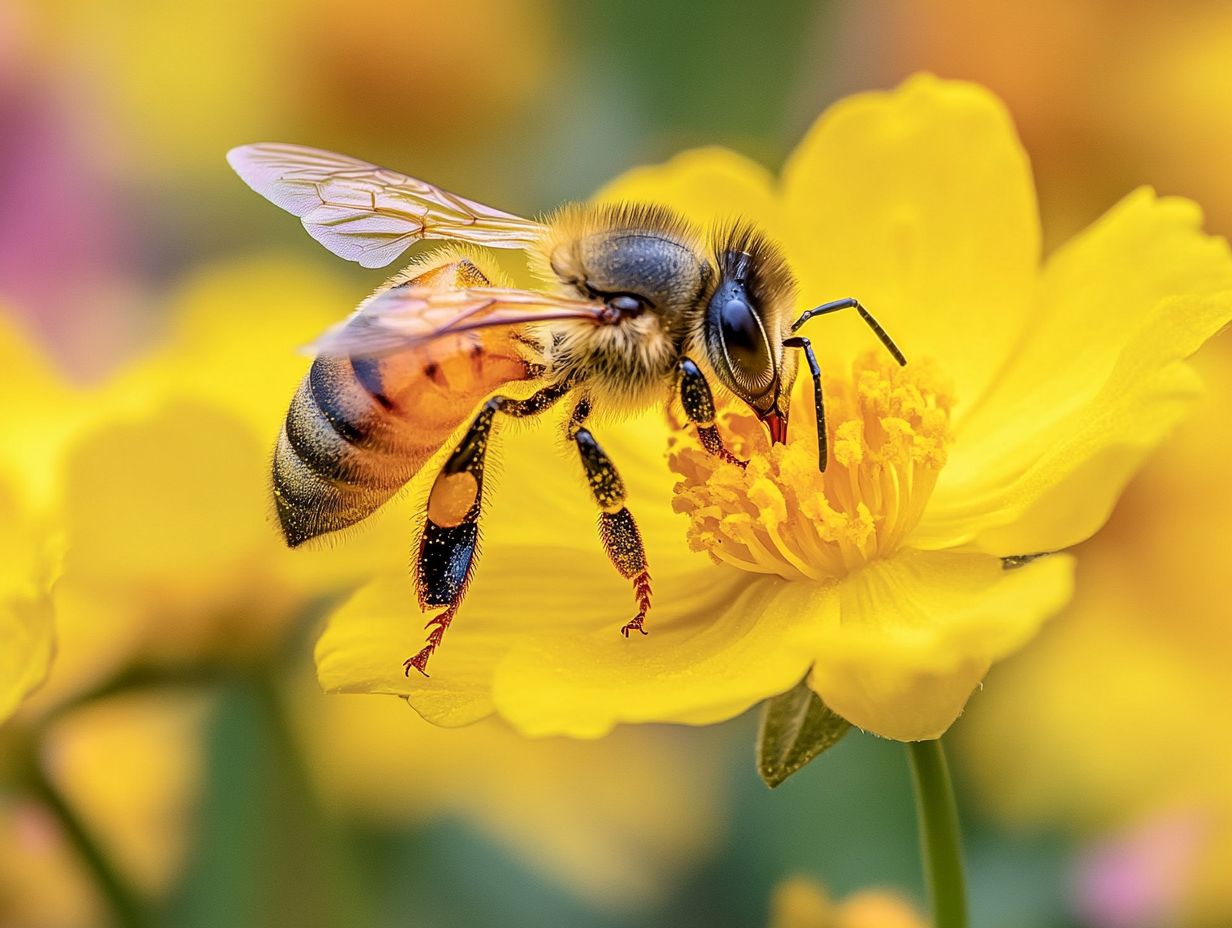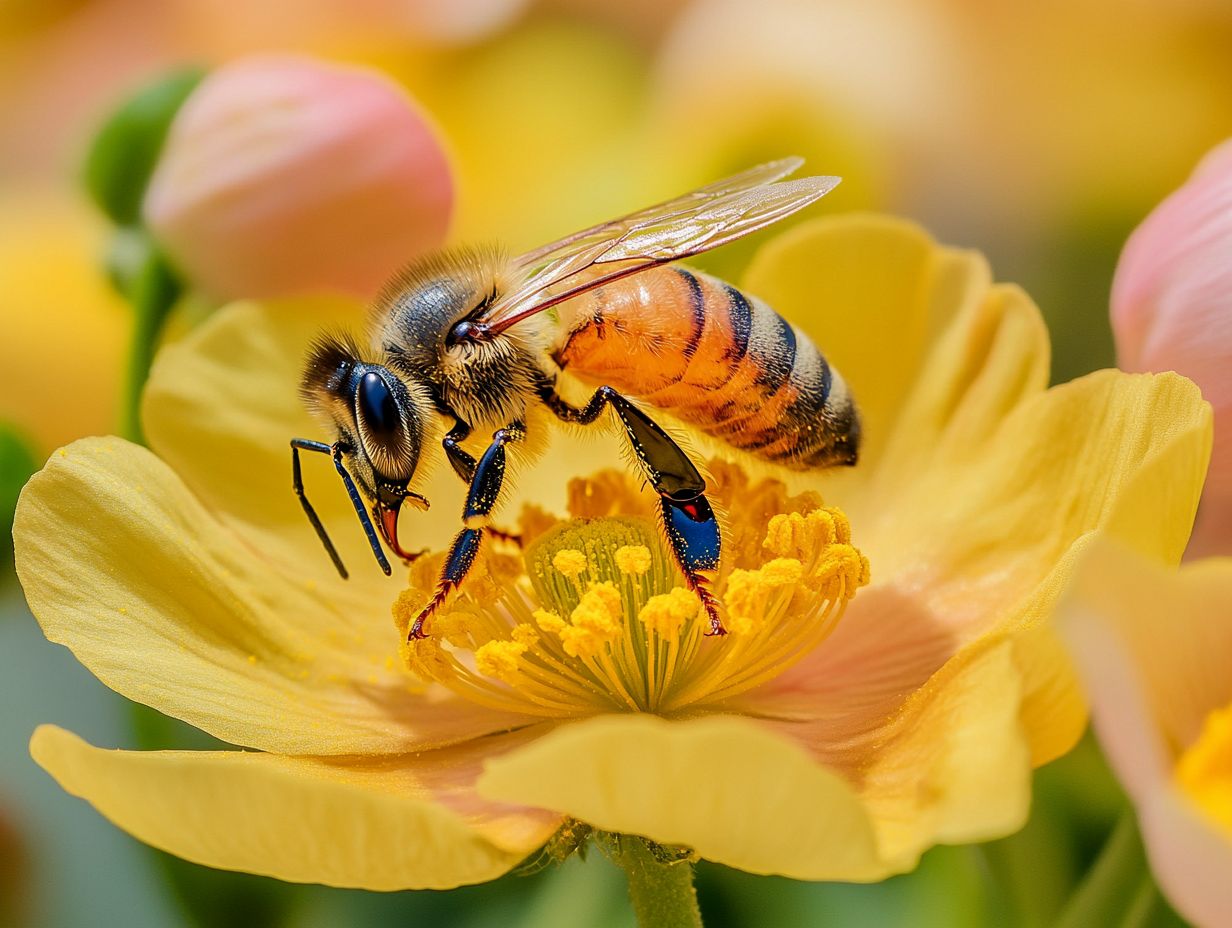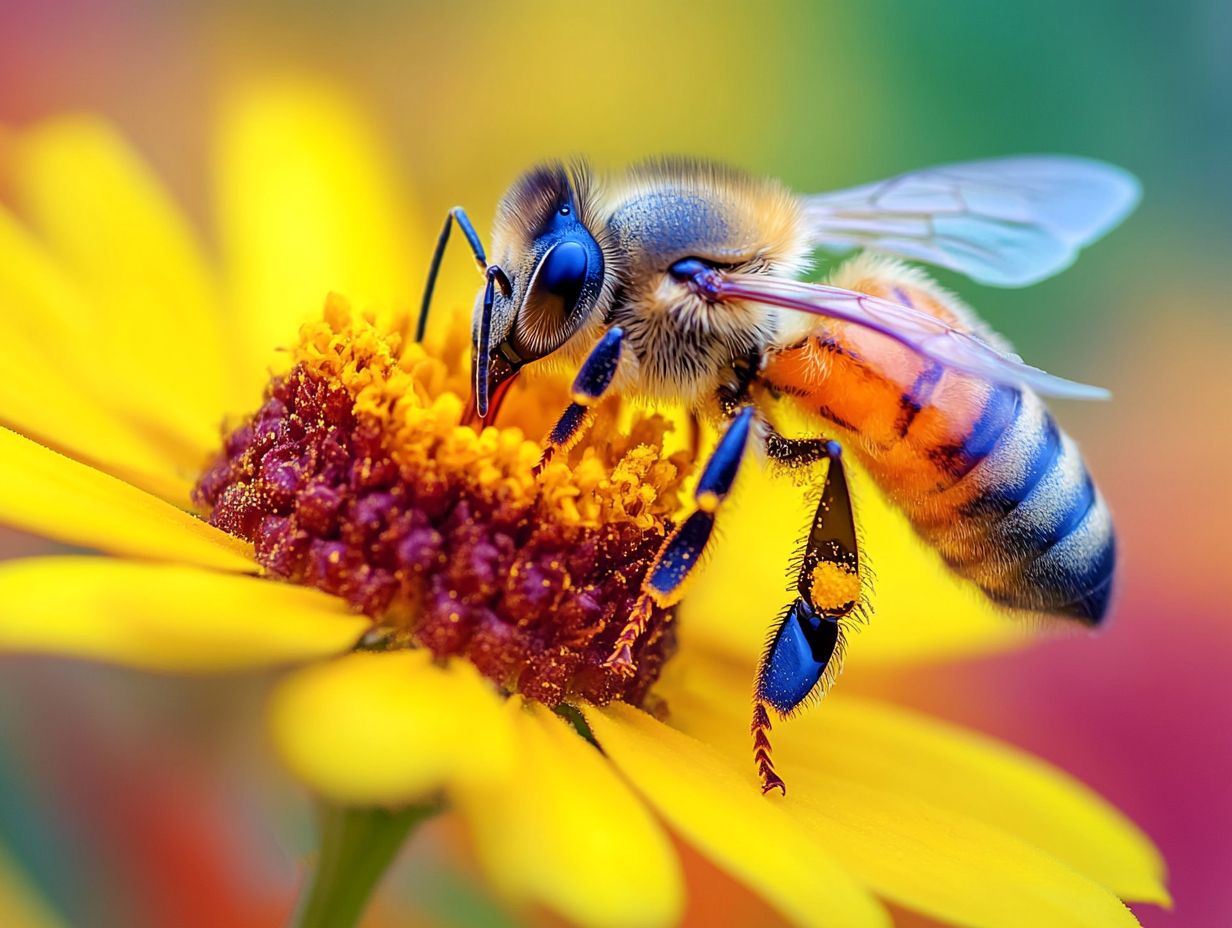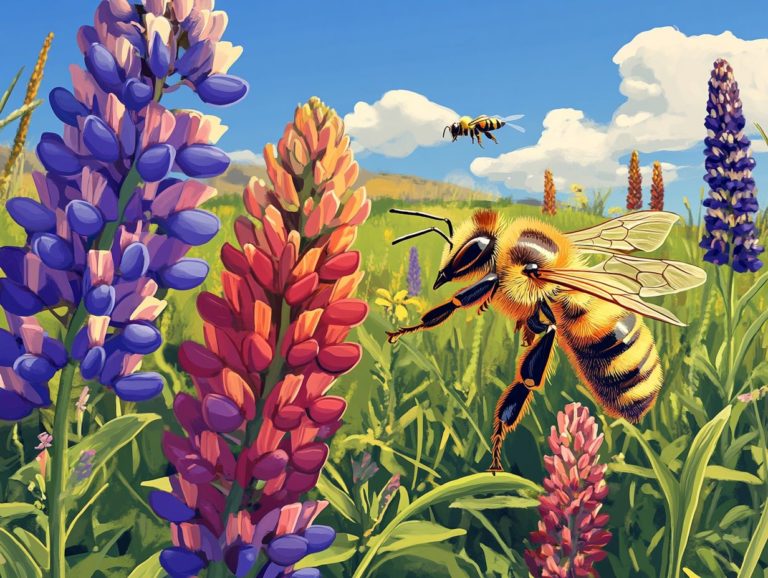Bees and Their Unique Foraging Behaviors
Bees are truly captivating creatures, playing an essential role in our ecosystem through their foraging and pollination activities.
From the complex social dynamics within the hive to the solitary journeys of individual bees, their foraging strategies are as diverse as the flowers they seek. Delve into the reasons why bees forage, the various types of foraging they exhibit, and the intricate ways they communicate during this essential activity.
You can learn how to support these vital pollinators by planting pollinator-friendly gardens. Join us on an exciting journey to uncover the secrets of bee foraging!
Contents
- Key Takeaways:
- What Is Foraging in Bees?
- Types of Foraging Behaviors in Bees
- How Do Bees Communicate During Foraging?
- Factors That Affect Bees’ Foraging Behaviors
- The Role of Foraging in the Survival of Bees
- How Can Humans Help Bees with Foraging?
- Frequently Asked Questions about Bee Foraging and Pollinator Activity
- What are some unique behaviors of bees when foraging, and how do they adapt to non-living environmental factors?
- Why do bees perform waggle dances while foraging, and what are the implications of this communication method?
- Do all bees forage for food, or do some have other roles?
- How do bees navigate when foraging, and what foraging challenges do they face?
- Do bees have a preference for certain types of food and flowering plants?
- How do bees communicate about food sources, and what communication methods do they use?
Key Takeaways:

- Bees forage to gather nectar and pollen for their survival and the survival of their colony. This includes activities like nectar collection and pollen provision.
- They exhibit different foraging behaviors, such as social and solitary foraging, and communicate using the waggle dance a special dance bees use to communicate the location of flowers pheromones, and other methods.
- Factors like weather, food availability, and distance from the hive can affect bees’ foraging. This behavior plays a crucial role in pollination, honey production, and colony growth. Humans can help by planting bee-friendly plants, avoiding pesticides, and providing a water source for bees.
What Is Foraging in Bees?
Foraging in bees is a vital behavior that revolves around gathering floral resources, mainly nectar and pollen, to fulfill the nutritional requirements of their colonies or solitary existence. This includes activities such as nectar collection and pollen provision.
Many factors shape this essential practice. These include food availability, environmental adaptations, and seasonal changes, all of which significantly influence foraging efficiency and reproductive success across various bee species, from solitary bees to honey bees. Temperature effects and habitat fragmentation also play a role in determining foraging success.
Understanding the complexities of foraging behavior reveals important ecological implications. It also sheds light on the urgent issue of declining pollinator populations.
Why Do Bees Forage?
Bees forage primarily to gather the essential food sources they need for survival. They focus on collecting nectar and pollen that contribute to their reproductive success and bolster the health of their colonies.
This behavior transcends a mere personal quest for sustenance; it holds immense significance in the broader ecological landscape. As bees engage in foraging, they inadvertently support the pollination of various plants, which is crucial for maintaining biodiversity and ensuring the stability of ecosystems. The interdependence between their foraging habits and successful pollination emphasizes their vital impact on agricultural yields and wild plant populations. For example, bee activity in pollinating crops like apple trees and cherry trees is essential for fruit production.
With the alarming decline in bee populations largely due to habitat loss, pesticide use, and climate change the motivations driving these insects to seek out food are increasingly jeopardized. This decline raises serious concerns about the reproductive strategies of both bees and flowering plants, highlighting the urgent need to ensure robust food sources within their habitats. By doing so, we can help secure their essential ecological role. Urban foraging and environmental entomology studies, like those from Princeton University Press, emphasize the importance of understanding these dynamics.
Let s work together to protect these incredible pollinators and ensure a thriving ecosystem.
Types of Foraging Behaviors in Bees
Bees display an impressive array of foraging behaviors that can be divided into two primary categories: social foraging, mainly seen in honey bees, and solitary foraging, typical of solitary bee species like Mason bees and Blue Orchard Bees. Each type of foraging behavior has evolved to help bees gather food efficiently and ensure their reproductive success.
Each foraging behavior is finely tuned to meet the distinct environmental and social needs of the bees. This showcases differences in foraging trips, resource usage, and competition for floral resources. By exploring these behaviors, you can gain valuable insights into their food-gathering efficiency and see how habitat fragmentation the breaking up of natural environments affects bee populations. Field studies, such as those by McKinney and Park in 2012, highlight these intricate behaviors.
1. Social Foraging
Social foraging is a fascinating behavior observed in social bees like honey bees. Multiple individuals work together to locate and efficiently use floral resources. They use advanced communication techniques, such as the waggle dance, to share important information about resource availability with their hive mates!
This remarkable process reveals the complex dynamics within bee colonies and shows how these pollinators skillfully adapt to the changing availability of flowers around them. Their ability to communicate effectively allows bees to make quick decisions about which flowers to visit, optimizing their food-gathering efforts.
However, environmental factors, especially habitat fragmentation, can significantly impact social foraging behaviors. As these bees navigate altered landscapes, they must adjust their strategies to cope with fewer flowering plants.
Through their remarkable adaptability, social bees enhance their food-gathering efficiency, ultimately ensuring the survival of their hive and the ecosystems they support!
2. Solitary Foraging
Solitary foraging refers to the amazing behavior of solitary bees as they independently seek and gather floral resources to nourish their brood cells. They ensure their offspring receive the nutrition needed in a competitive landscape filled with variable resource availability.
These incredible insects skillfully navigate various environments, adapting their food-gathering strategies in response to the ever-changing availability of flowers and other resources. Unlike their social counterparts, solitary bees face unique challenges, especially in resource-scarce areas where competition for food is intense. Solitary bees like the Blue Orchard Bee and Mason bees are particularly skilled at overcoming these obstacles!
Their foraging trips not only fulfill the nutritional needs of their larvae but also play a crucial role in pollinating various plants, supporting ecological balance. For instance, solitary bees are especially important in pollinating crops such as herb plants and flowering plants that are essential for garden ecosystems.
By ensuring the survival of diverse plant species, solitary foragers are essential for maintaining bee diversity and the overall health of ecosystems. They create a rich web of interactions that support not only their own survival but also the activity of other pollinators. Their contributions are vital for maintaining ecosystem stability and biodiversity!
How Do Bees Communicate During Foraging?
Bees utilize an impressive range of communication techniques while foraging. Social bees, such as honey bees, use the waggle dance a fascinating method that conveys important information about the location and quality of floral resources. These communication methods are essential for effective food gathering.
They also release pheromones to show their success in finding food, effectively attracting fellow foragers to the most rewarding sites. This is crucial for optimal resource allocation within the colony!
1. The Waggle Dance

The waggle dance is an extraordinary communication method that honey bees use to inform their hive mates about the distance and direction of floral resources. This optimizes foraging efficiency and ensures the colony has access to essential food sources.
This amazing dance is crucial for success. The dancer performs a series of intricate movements waggling their bodies and executing precise turns conveying vital information about the location of nectar and pollen-rich flowers. This fascinating behavior indicates the distance to these resources through the duration of the waggle run and aligns the orientation of the dance with the angle of the sun.
Such precise communication maximizes foraging efficiency. It enables bees to gather the necessary supplies to sustain the hive s population. Ultimately, your ability to convey this information is crucial for the colony s survival, ensuring that nutritional needs are consistently met.
2. Pheromones
Pheromones are essential to understanding bee foraging behavior. They act as chemical signals that convey critical information about resource availability, brood cells, and foraging success among bees. This intricate communication influences their collective foraging strategies.
These remarkable chemical cues enable bees to make informed decisions about which flowers to visit, enhancing their foraging efficiency. When scout bees release specific pheromones, they alert their companions to abundant floral resources, prompting a swift and effective response from other workers. The release of brood pheromone triggers specific foraging patterns within the hive.
This coordinated communication maximizes the bees’ harvesting capabilities. It ensures optimal resource allocation within the colony. As a result, the overall effectiveness of their pollination activities is significantly improved, underscoring the vital role bees play in the ecosystem and agriculture. This is essential for maintaining healthy bee populations and ensuring the survival of various bee species.
By diving into these chemical interactions, you gain valuable insights into the complexities of bee behavior and the stability of their populations.
Factors That Affect Bees’ Foraging Behaviors
Numerous factors shape bees’ foraging behaviors. Among these, environmental elements like temperature, the availability of floral resources, and fluctuating weather patterns heavily influence how far bees travel to forage and their overall activity levels in various environments across the seasons. Understanding these factors can dramatically improve your bee colony’s success!
1. Weather Conditions
Weather conditions significantly influence bee foraging behavior. Factors like temperature and precipitation shape overall activity and the efficiency with which bees gather nectar and pollen from flowers.
Seasonal changes and fluctuating weather patterns impact foraging distances and efficiency. Temperature extremes can alter the duration and intensity of foraging trips, as bees thrive within specific thermal ranges.
When temperatures rise, bees may halt foraging altogether to avoid overheating. Cooler conditions can lead to a dip in bee activity. These temperature effects highlight the importance of environmental factors in shaping bee foraging strategies.
Humidity levels also play a critical role, affecting the moisture content of nectar and its availability as a food source. Bees tend to favor foraging in conditions where humidity allows for optimal foraging efficiency and flight efficiency.
Meanwhile, unpredictable precipitation patterns brought about by climate change complicate bees’ ability to anticipate flowering times. This disrupts established foraging routines and diminishes their resources, jeopardizing bee populations and impacting the crucial pollination services that underpin global food production.
The Role of Foraging in the Survival of Bees
Foraging is crucial for the survival of bees. It is the primary way they gather essential food. It also plays a key role in pollination, honey production, and the growth and reproductive success of their colonies. This includes the vital development of brood cells. Different bee species exhibit unique foraging patterns influenced by environmental factors.
1. Pollination

Pollination is an essential ecological service that benefits you while bees diligently forage to help flowering plants reproduce. This process is vital for maintaining healthy ecosystems and promoting biodiversity among various bee species.
The importance of pollination stretches far beyond plant reproduction. It directly supports food production for countless organisms, including humans, while bolstering ecosystem resilience. Different bee species display unique foraging behaviors, targeting specific floral resources to ensure efficient pollen transfer.
This specialized interaction not only helps various plant species thrive but also creates a rich habitat that supports a wide array of wildlife, including birds. The health of an ecosystem is intricately connected to its pollinators. Their foraging habits contribute to the relationships between flora and fauna.
By recognizing and understanding these interactions, you can appreciate the crucial role bees play in maintaining ecological balance and promoting the overall health of our ecosystems!
2. Availability of Nectar and Pollen
The availability of nectar and pollen shapes how you search for food as a bee. Fluctuations in floral resource availability can lead to food scarcity. This, in turn, influences your foraging strategies and reproductive success.
When floral resources start to decline, you must adapt your foraging methods. This often means taking longer trips or changing your routes to maximize resource intake. The stress of searching for food can weaken your population, impacting not just individual bees but entire colonies.
If certain flowers bloom less frequently or are absent, you may struggle to gather enough supplies for nourishment and hive growth. This inadequate availability disrupts your natural foraging efficiency, posing significant threats to your survival and to the ecosystems that rely on you for pollination.
3. Distance from the Hive
The distance from the hive affects how you find food. Both solitary bees and social bees must carefully balance the energy they expend during foraging trips with the resources available around them. They often adjust their distances based on changing conditions.
By evaluating resource density in their surroundings, these bees use various strategies to optimize their foraging efforts. For example, social bees like honey bees may venture farther when they detect abundant floral resources in their territory. They leverage sophisticated communication methods, such as the waggle dance, to share information about food sources.
In contrast, solitary bees tend to forage within a limited radius to maximize their energy efficiency. This foraging distance not only influences the amount of food collected but also has significant implications for bee health and survival.
Traveling too far can stress you out and expose you to a higher risk of predator encounters, ultimately affecting population dynamics and contributing to bee decline.
2. Honey Production
Honey production in social bees, especially honey bees, depends on their foraging behavior. The ability to efficiently collect nectar from various floral resources is crucial for determining both the quantity and quality of the honey produced.
The dynamic relationship between resource availability and foraging strategies significantly impacts honey yields. When floral resources are plentiful, bees demonstrate more effective foraging patterns. This optimization boosts both the volume of nectar collected and enhances the diversity of floral sources, elevating the flavor profiles of the honey created.
In times of scarcity, bees must adapt their foraging tactics, which can influence both the quantity and quality of honey produced. Ultimately, this interplay highlights the necessity of a diverse and abundant environment for thriving honey production.
3. Colony Growth and Reproduction
The foraging behavior of bees is crucial to colony growth and how bees grow and reproduce. The resources gathered during foraging directly impact the development of spaces where baby bees develop and the overall health of the colony, especially in social species.
High-quality pollen and nectar are essential for nurturing the next generation. This relationship underscores the critical link between resource collection and the reproductive success of solitary bees, which often depend on specific floral resources.
Effective foraging behaviors are crucial for optimizing reproductive output and maintaining the delicate balance of ecosystem interactions. Social bees play a vital role in these dynamics, emphasizing the importance of communication methods like the waggle dance, a dance that bees use to communicate the location of food sources.
How Can Humans Help Bees with Foraging?
You can make a big impact on bee foraging by crafting environments rich in bee-friendly plants. Minimizing pesticide use and providing essential resources, such as accessible water sources, enhance the foraging capabilities of both solitary and social bees.
Implementing sustainable agricultural practices helps mitigate pest threats and supports the overall health of bee populations. Your actions can significantly nurture these vital pollinators and promote a thriving ecosystem.
1. Planting Pollinator-friendly Gardens
Planting pollinator-friendly gardens is one of the most effective ways to support bees and other pollinators. These gardens offer a wealth of floral resources that cater to their foraging needs, addressing challenges posed by habitat fragmentation.
By thoughtfully selecting a variety of bee-friendly plants, you can create a sanctuary that attracts diverse bee populations and enhances their health and well-being.
Here s how you can do it:
- Include a vibrant mix of native wildflowers, fragrant herbs, and flowering shrubs.
- Plant cherry trees and apple trees for a rich tapestry of colors and scents.
- Stagger the blooming periods to ensure a continuous supply of nectar and pollen.
This sustainable approach to gardening beautifies your space and significantly enhances local biodiversity. It plays a crucial role in the ecosystem, enabling bees to thrive as they carry out their essential pollination activities. Encouraging urban foraging through such gardens can mitigate habitat loss effects and create new opportunities for bees to flourish.
Join the movement to create bee-friendly gardens and help our pollinators thrive!
2. Avoiding Pesticides
Avoiding pesticides is absolutely essential for preserving bee health. These chemicals can have a detrimental effect on their foraging behavior. They reduce resource availability and contribute to the alarming decline of these critical pollinators.
Pesticide exposure also exacerbates other threats, such as the proliferation of Varroa mites, a type of parasite that harms bees. Pesticides hinder bees’ ability to find and collect nectar and pollen, which hampers their foraging efficiency.
This disruption threatens their immediate survival and carries significant repercussions for the entire ecosystem. Bees are integral to pollination a cornerstone of food production and plant diversity. Environmental entomology studies have shown the broad impacts of pesticide use on pollinator health.
The negative impact of these chemicals can weaken bees’ immune systems, making them more vulnerable to diseases and environmental stressors. Therefore, advocating for sustainable agricultural practices that prioritize organic methods is absolutely crucial! By doing so, you can help mitigate these risks, fostering a healthier environment for bees and securing the food sources we all rely on for generations to come.
Supporting research from organizations such as the USDA can further aid in developing strategies to protect bee populations.
3. Providing a Water Source
Providing a clean water source is essential for supporting bee activity. Bees require access to water not only for hydration but also for regulating hive temperatures, diluting honey, and producing brood pheromone, which enhances their foraging efficiency and overall colony health.
This vital resource plays a pivotal role in the overall health and productivity of the colony. When you maintain proper hydration levels, bees are better equipped to cope with environmental stressors and engage in their complex foraging behaviors, such as collecting nectar and exchanging pollen.
Water also aids in the construction of honeycomb and is crucial for the development of larvae, making it a foundational element of hive maintenance. Furthermore, the availability of water helps bees manage temperature effects inside the hive.
Establishing diverse and accessible water sources encourages a sustainable ecosystem that ultimately benefits not just the bees, but the surrounding plants that rely on these diligent pollinators for reproduction. This practice also supports various bee species, including solitary bees and social bees, which have different foraging strategies and reproductive successes.
Be sure to watch our video on foraging efficiency and bee activity below:
Watch our video to learn how bees forage efficiently!
Frequently Asked Questions about Bee Foraging and Pollinator Activity

What are some unique behaviors of bees when foraging, and how do they adapt to non-living environmental factors?
Bees exhibit various unique behaviors when foraging:
- Performing waggle dances to communicate food sources
- Using polarized light to navigate
- Marking food sources with pheromones
They adapt their foraging behavior based on resource availability and environmental adaptations.
Why do bees perform waggle dances while foraging, and what are the implications of this communication method?
Waggle dances allow bees to communicate the distance and direction of a food source to their fellow hive members. This communication method helps them efficiently gather food and maximize their foraging efforts while adapting to seasonal changes and weather patterns.
Do all bees forage for food, or do some have other roles?
No, not all bees are responsible for foraging. While worker bees are the main foragers, other bees, such as drones and queen bees, have different roles within the hive. Forage patterns may vary among different bee species, influenced by their specific reproductive strategies and habitat fragmentation.
Bees are incredible navigators! They detect the sun’s position in the sky using polarized light, acting like a compass to guide them back home.
However, they encounter various foraging challenges. These include competition for floral resources and adapting to foraging in urban areas, where flowers may be less abundant.
Do bees have a preference for certain types of food and flowering plants?
Absolutely! Bees prefer different food sources based on their needs, what s available, and the season.
They even have specialized foragers for specific types of food, such as nectar or pollen. Preferences for flowering plants can vary, influenced by the availability of floral resources and findings from environmental entomology studies.
How do bees communicate about food sources, and what communication methods do they use?
Bees communicate about food sources not just with waggle dances but also through pheromones. These chemical signals help guide other bees to tasty finds and mark the source for future visits.
Such communication methods are crucial for coordinating foraging trips and ensuring foraging efficiency.






